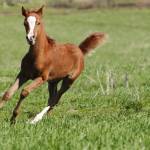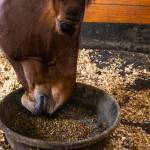Energy Requirements of Growing Horses

Setting standards to feed growing horses requires owners to revise amounts of grain and forage as the animals continue to become taller and heavier. Recommended values for typical Thoroughbred, Standardbred, Quarter Horse and other light breeds with mature body weights of 1,150 to 1,200 lb (522 to 544 kg) can be lowered or raised for smaller and larger horses.
Discussions about whether moderate growth would be better than rapid growth are useful, and this area deserves much more study. However, horse operations that are producing animals for weanling and yearling sales, halter shows, or two- and three-year-old racing, or those that just want horses which “look” competitive, really have little choice. Their goal has to be rapid growth, if not maximum growth, with as few developmental and health problems as possible.
Rapid growth rates obviously require liberal amounts of energy and protein. To answer questions such as when to feed, how much to feed, and what feed form to use, it is helpful to break the entire growth period into management phases beginning with suckling and weanling foals.
The most growth in the shortest period of time occurs in the foal from birth to weaning. It is normal on successful commercial horse farms for foals to grow from about 10% of mature body weight at birth to nearly 50% of mature body weight at weaning. Daily gains are 2.3 to 2.4 lb (1 kg) per day during the suckling phase for foals weaned at 6 months of age and even greater for earlier weaned foals. Mare milk is the only significant food the suckling foal receives during the first few weeks of its life and normally continues to be its major source of nutrients until the foal is 4 to 5 months of age.
Calculations based on weight gains of foals receiving mare milk and known amounts of supplemental feed indicate that mares are producing milk in the 3 to 4% of body weight range. This level of milk production accounts for the high DE requirements observed in lactating mare studies. Rapid growth rates in foals result in rapid increases in body weight, and consequently rapid increases in digestible energy (DE) requirements for maintenance, while at the same time milk production by the mare begins to decline. Clearly, the foal must have other sources of nutrients if it is to continue to grow at rapid rates. Pasture studies with mares and foals indicate that older foals get significant amounts of nutrients from high-quality pasture. The same would be expected when high-quality hay is available to the foal. Under such conditions, foals consume supplemental concentrate at a rate of about 1% of body weight. Calculations indicate that under pasture conditions, older foals probably consume about 3% of body weight as feed dry matter, approximately equally divided between mare milk, pasture or hay, and concentrate. When pasture or hay is limited or poor quality, or mare milk production is low, voluntary concentrate intake will increase.
To feed weanlings properly requires good management and the application of more nutritional knowledge than that required for any other class of horse. It is not unusual to see weanlings that are thin and pot-bellied with rough hair. Foals that have been weaned for two or three months may be in poor condition, having gained little or no weight since weaning. Some owners accept such minimal performance in weanlings as normal and unavoidable. It may be normal for some and it is arguable as to whether this is harmful to the horse, but it can be avoided by using the least stressful method of weaning, continuing good health care for the weanling horse, and providing rations with the proper nutrient density and balance. A balanced diet and a full belly will probably increase immunity to, and/or help with recovery from, some diseases and possibly help to minimize weaning stress as well.
Daily weight gains for weanlings of 1.4 to 1.9 lb (0.6 to 0.9 kg) per day appear to be reasonable based on experimental and farm observations. Practical and experimental observations indicate that 450- to 500-lb (204- to 227-kg) weanlings will consume a maximum of 2.8% to 2.9% of body weight of air dry matter. Thus, the total air dry matter intake for a 500-lb (227-kg) foal can be expected to be about 14.5 lb (6.6 kg) per day after a two- to three-week adjustment period.
Weanling diet recommendations for weight gains of 1.4 and 1.9 lb (0.6 to 0.9 kg) per day range from 70% hay and 30% grain for very slow growth, to 20% to 25% hay for rapid gains of 1.8 lb to 1.9 lb (0.8 to 0.9 kg) per day, with 35% to 40% hay for more moderate gains of 1.3 lb to 1.4 lb (0.6 kg) per day.
Weanlings on any diet should have their growth measured regularly and amounts of grain and hay should be adjusted according to the response of individual animals to diet.








